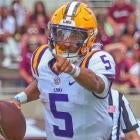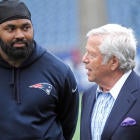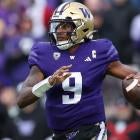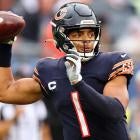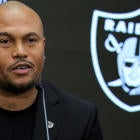Much like its AFC counterpart, the NFC Championship Game set to take place this Sunday is a rematch of a game that was played earlier this season. The New Orleans Saints and Los Angeles Rams met way back in Week 9, with the Saints prevailing by a score of 45-35 to hand L.A. its first loss of the season.
Unlike the AFC title game, the NFC rematch will be taking place in the same location: the Mercedes-Benz Superdome in New Orleans. That means this game will be unaffected by any weather concerns, and could turn into yet another track meet between two of the highest-scoring teams in football.
Even if that track meet doesn't break out again, the game is sure to be entertaining. There are stars everywhere on the field in this one, with Drew Brees and Michael Thomas and Alvin Kamara and Jared Goff and Todd Gurley and Brandin Cooks and Robert Woods and Aaron Donald and Cameron Jordan and Ndamukong Suh and Marshon Lattimore and Aqib Talib and ... C.J. Anderson, suddenly. And more.
Throw in two of the most creative offensive minds in football in Sean Payton and Sean McVay, one of the best defensive coordinators ever in Wade Phillips, a strong defensive mind in his own right in Dennis Allen, who has turned the Saints' defense around over the past two years, and you've got the recipe for a wildly entertaining football game that as an added bonus gets to decide which team will represent the NFC in the Super Bowl.
Here's what you should be watching out for when the two teams take the field on Sunday afternoon. You can stream the game on fuboTV (Try for free) or watch on Fox at 3:05 p.m. ET.
Saints run defense vs. Rams RBs and dominant O-Line
Last week in the divisional round, the Rams lined up against one of the best run defenses in football and absolutely pulverized them. The Dallas Cowboys finished the regular season with the league's fifth-best run defense, per Football Outsiders' DVOA, and were coming off a game where they had held Seahawks running backs to 59 yards on 21 carries.
By the end of the first half, two different Rams running backs (Gurley and Anderson) had more than 59 yards rushing, and by the end of the game, they each damn near doubled that total on their own. Gurley, in his first game back from a multi-week injury, rushed 16 times for 115 yards and a touchdown. Anderson, splitting carries with Gurley for the first time since being signed off the street and thrust into the lead back role, powered through the Dallas defense for 123 yards and two scores on 23 carries. It was an absolutely dominant performance from both backs, but it was powered by an offensive line that cleared the way for them to average 2.54 yards per carry before contact, a far cry from the 0.90 per carry the Seahawks had averaged the week before.
Rams offensive linemen insisted this week that they knew which stunts the Cowboys were running on 90-plus percent of their plays based on alignment and other tells, but, well, they still had to make the right blocks. And boy, did they ever. Though the Cowboys had a fantastic run defense, the fact that the Rams were able to plow through them on the ground should perhaps not have been a surprise. After all, L.A. had one of the best run-blocking units in the NFL during the regular season. The Rams finished first in the NFL in Football Outsiders' Adjusted Line Yards, which assigns credit in the run game to the offensive line based on a percentage of yards gained per carry. They also had the second-lowest percentage of their runs stuffed at or behind the line of scrimmage, at just 14.6 percent.
Much of their ability to run the ball with clear lanes and without being stuffed stemmed from their personnel. The Rams spent almost the entire regular season in 11 personnel, with one tight end, one running back, and three wide receivers on the field. (And almost always the same exact 11 players, for that matter.) Doing so often forced defenses into light formations with a nickel back on the field, and to have seven defenders (at most) in the box. That's the reason only 8.2 percent of Gurley's carries during the regular season came against a box stacked with eight defenders or more, the third-lowest rate in the league behind only Tarik Cohen and Wendell Smallwood. Even against Dallas last week, only one of Gurley's 16 carries came against an eight-man box. Similarly, only four of Anderson's 23 carries came against eight-man boxes.
On Sunday against the Saints, Los Angeles' ability to dictate defensive fronts and still run the ball with ease will be tested against a run defense that was even better than the Cowboys' during the regular season. New Orleans allowed the fewest yards per carry in the NFL during the regular season, and ranked second in run defense DVOA, sixth in stuff rate (23.7 percent of opponent runs were stopped at or behind the line of scrimmage), third in opponent's power success (57 percent of runs or third or fourth down with two or fewer yards to go resulted in conversions), first in second-level yards per carry, and third in open-field yards per carry.
New Orleans was strong up front all season, with several defenders who could either soak up blockers or knife between them to make plays in the backfield. (Hi, Cameron Jordan, whose 38 run stops ranked seventh among all edge defenders, per Pro Football Focus.) Their linebackers flowed to the run as well as any in the league, with Demario Davis in particular ranking among the best second-level run defenders in the NFL. The Saints fared extremely well against the Rams' favorite run play, outside zone, on which they allowed only 3.3 yards per carry all year, per Sports Info Solutions. The Rams had 280 outside zone carries, most in the NFL. They ran for 1,555 yards on outside zone, most in the NFL, and 946 of those yards came after contact, most in the NFL. Those runs resulted in 84 first downs and 14 touchdowns, most in the NFL. And they averaged 5.6 yards per carry on those plays, best in the NFL.
The Saints were incredibly stout against outside runs overall, with their vulnerability coming more on runs directly up the middle. That vulnerability could be exacerbated this week as they'll be without the services of stud defensive tackle Sheldon Rankins, who suffered a torn Achilles during last week's win over the Eagles. Among 115 interior defenders who played at least 250 snaps this season, per Pro Football Focus, Rankins ranked 14th in run stops. He's not the Saints' best run defender, but he's a good one, and removing him from the lineup certainly affects things. The Saints still have David Onyemata and their linebackers to work up the middle, but things will be different without Rankins eating up blockers and providing clean lanes for Davis and A.J. Klein and company to flow through. Things could get interesting if the Rams go to more 12 personnel (one back, two tight ends, two receivers) as they did last week against Dallas and use one of the two as a move man and lead blocker up the middle, clearing space where Rankins used to be. New Orleans was more effective stopping the run against 11 personnel than 12, oddly enough, so that could be something to watch out for on Sunday as well.
Rams back seven vs. Saints dangerous triplets
During the first game between these two teams, it was ultimately the Rams' inability to stop either Michael Thomas or Alvin Kamara that doomed them. Thomas absolutely torched the Rams' secondary for 12 catches, 211 yards, and a touchdown, with Marcus Peters catching the brunt of it as Thomas caught seven of nine passes thrown his for 146 yards and the aforementioned TD when he was covered by Peters during the game. Kamara, meanwhile, carried 19 times for 82 yards and two touchdowns, scooting around the edges of the formation and breaking tackles seemingly at will. He added four catches for 34 yards and yet another score, smoking whatever linebacker or safety the Rams assigned to cover him. Needless to say, the Rams absolutely need to figure out a way to avoid a repeat performance if they want to figure out a way to reverse the result this time around.
There is no real strategy a team can employ where you can safely say, "That's how you stop Thomas and Kamara." Despite them both operation in many of the same areas of the field, they are vastly different players who pose far different problems for opposing defenses.
| Saints | Thomas | Kamara | Others |
|---|---|---|---|
| Rec | 119 | 81 | 164 |
| Target | 139 | 104 | 246 |
| Comp % | 85.6% | 77.9% | 66.7% |
| Tgt % | 28.4% | 21.3% | 50.3% |
| Yards | 1,332 | 709 | 1,951 |
| Yds/rec | 11.2 | 8.8 | 11.9 |
| TD | 9 | 4 | 19 |
| TD % | 6.47% | 3.85% | 7.72% |
| INT | 1 | 1 | 3 |
| INT % | 0.72% | 0.96% | 1.22% |
| 1st dn | 72 | 32 | 99 |
| 1st % | 51.80% | 30.77% | 40.24% |
| QB Rtg | 125.2 | 103.9 | 111.4 |
Thomas uses a combination of elite size (6-foot-3, 212 pounds), strength, change of direction ability, and absurdly large (10.5-inch) and practically vacuum-sealed hands to destroy defenses in close quarters. According to NFL.com's Next Gen Stats, Thomas received only 4.6 yards of cushion on the average snap. Of the 125 players who were targeted at least 43 times during the regular season, only four received less of a pre-snap cushion than Thomas. Thomas also averaged only 2.7 yards of separation on his targets, which puts him in company with players like, well, Jordy Nelson. And he often operated incredibly close to the line of scrimmage, with his averaged throw coming only 7.7 yards downfield, an area often frequented by the likes of Julian Edelman, who on the surface does not at all seem like a similar player to Thomas.
Here's how automatic Thomas was on those kind of passes: On throws within 10 yards of the line of scrimmage, Brees was a completely ridiculous 95 of 104 (91.3 percent) for 694 yards, five touchdowns, and not a single interception when targeting Thomas. That works out to a 110.5 passer rating and given the near-automatic nature of those throws, it's essentially like averaging 6.67 yards per rush attempt. Press Thomas too much to take those throws away, though, and he can easily beat you in the intermediate game as well: on throws between 11 and 20 yards downfield, Brees was 34 of 46 for 594 yards, three touchdowns, and a pick when targeting Thomas. That's a 128.4 passer rating, by the way. He's so good in close quarters that it almost doesn't make sense to cover him with just one man, but if you sit in zone, well, just ask the Eagles what can happen then. (Thomas caught 12 of 16 passes for 171 yards and a touchdown against Philadelphia last week.)
Kamara is stouter than people think he is (5-foot-10, 215 pounds) but he still primarily beats you with his ability in open space. He doesn't have elite speed (he ran the 40-yard dash in 4.56 seconds) but he has some of the best change-of-direction ability in the NFL and if you try to cover him with a linebacker or safety, you're pretty much toast. Kamara ranked fourth among 37 running backs who were targeted at least 30 times during the regular season in yards per route run, so he was efficient as well as explosive.
He's also incredibly versatile, having been aligned in the backfield on 74 percent of passing plays, per PFF, while he was in the slot 15 percent of the time and out wide in 11 percent of his passing snaps. He received 28 of his 104 targets when in the slot or out wide, so the Saints are not afraid to use him essentially as a wide receiver in order to get the matchup they like. On Sunday, that matchup would presumably be against Corey Littleton or Samson Ebukam, or even John Johnson III or Lamarcus Joyner, whom Kamara beat a couple times in the first matchup. If the Rams start putting extra defensive backs on the field because Kamara is out there, well, the Saints will just run the football, which they did as well as almost anyone in the league.
The Los Angeles pass defense had a few issues this season, but it was far better when Aqib Talib was in the lineup and it was really damn good against short passes (sixth in DVOA). Talib may get the assignment against Thomas on the perimeter in this game, but that would come much to the chagrin of Peters, who has been publicly champing at the bit to get another shot against the Saints star. Talib almost always played on the left side of the field this season (92 percent of his snaps, per PFF), but if the Rams believe Peters is just not equipped to deal with Thomas, Talib could shadow Thomas wherever he goes. That would leave Peters against the likes of Ted Ginn and/or Keith Kirkwood and/or one of the tight ends, who are far easier to deal with. Thomas bumps down into the slot fairly often, but the Rams leaving slot corner Nickell Robey-Coleman inside to deal with him one-on-one seems like a recipe for disaster, given Thomas' size advantage.
The one man who really has the potential to wreck the New Orleans passing game is Aaron Donald, who is the best defender and possibly best player in the entire league. But we've seen teams like the Bears figure out a way to at least hold Donald in check, double-teaming him on almost every pass play and getting the ball out as quickly as humanly possible when he's got single coverage. That's where Kamara comes in, as a quick release valve for Brees that can also make any defender miss in space and create yards after the catch.
Prediction: Saints 30, Rams 24














